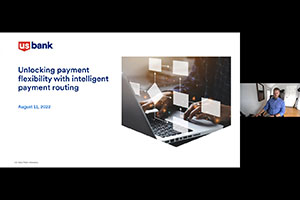
How blockchain technology is changing treasury

Solutions banks can offer during the COVID-19 pandemic

Colleges respond to student needs by offering digital payments

Benefits of billing foreign customers in their own currency

Hospitals face cybersecurity risks in surprising new ways

Transition to international ACH

Take a fresh look: mass transit is going places

5 reasons to upgrade B2B payment acceptance methods

Creating the ideal patient journey

Drive digital transformation with payments innovation

Beyond the back office: real-time payments

Making the cross-border payment decision: Wire or international ACH?

Leading the way for real-time payments

Real-time payments fuel innovation

Real-time answers about real-time payments

Webinar: Transform your business with automated payables

Modernizing fare payment without leaving any riders behind

Consolidating payments for healthcare systems

Standardizing healthcare payments

Integrated payments healthcare benefits

Access, flexibility and simplicity: How governments can modernize payments to help their citizens

How the next evolution of consumer bill pay makes it easier to do business

Role of complementary new channels in your payments strategy

Navigate changing consumer behavior with service fees

Unlocking payment flexibility with intelligent payment routing

Escheatment resources: Reporting deadlines for all 50 states

How electronic billing platforms improve government payments

Webinar: Approaching international payment strategies in today’s unpredictable markets.

White Castle optimizes payment transactions

Payment industry trends that are the future of POS

What government officials should know about real-time payments

Higher education strategies for e-payment migration, fighting fraud

Tap-to-pay: Modernizing fare payments pays off for transit agencies and riders

ABCs of APIs: Drive treasury efficiency with real-time connectivity

How emerging banking solutions enable better decisions

Restaurant survey shows changing customer payment preferences

Three healthcare payment trends that will continue to matter in 2022

Want AP automation to pay both businesses and consumers?

Time is money: Intelligent Payment Routing saves businesses both

Digital trends poised to reshape hotel payments

Managing the rising costs of payment acceptance with service fees

Webinar: CSM corporation re-thinks AP

Webinar: A closer look at U.S. Bank AP Optimizer

Digital banking for business: How connectivity improves customer experience

Banking connectivity: Helping businesses deliver the easier, faster, more secure customer experience of the future

Adjust collections to limit impact of USPS delivery changes

How to improve digital payments security for your health system

Increase working capital with Commercial Card Optimization

Luxury jeweler enhances the digital billing and payment customer experience

Enhancing the patient experience through people-centered payments

Tech tools to keep your restaurant operations running smoothly

Unexpected cost savings may be hiding in your payment strategy

Crack the SWIFT code for sending international wires

3 ways to adapt to the new payments landscape

Automate escheatment for accounts payable to save time and money

ePOS cash register training tips and tricks

3 benefits of integrated payments in healthcare

Cashless business pros and cons: Should you make the switch?

How COVID-19 is transforming healthcare payments

Automate accounts payable to optimize revenue and payments

A simple guide to set up your online ordering restaurant

Top 3 ways digital payments can transform the patient experience

Addressing financial uncertainty in international business

Rent payments: What’s changing for commercial real estate

Understanding and preparing for the new payment experience

What to know when investing in AP automation solutions

Webinar: AP automation for commercial real estate

Ways prepaid cards disburse government funds to the unbanked

Principles to pursue in revitalizing Accounts Payable

How to accept credit card payments without transaction fees

3 reasons governments and educational institutions should implement service fees

How AR technology is helping advance payment processing at Avera Health

Top tips for card payments optimization

The benefits of payment digitization: Pushing for simplicity

COVID-19 safety recommendations: Are you ready to reopen?

Collect utility and telecom bill payments faster

Government billing survey: The digital transformation of the payment experience

5 winning strategies for managing liquidity in volatile times

Safeguarding the payment experience through contactless

Higher education and the cashless society: Latest trends

Ease your transition to remote banking

Zelle® helps Sunriver Resort make payments efficient and secure

3 ways to make practical use of real-time payments

Buried treasure: Maximizing analytics for treasury management

Artificial intelligence in finance: Defining the terms

How AI in treasury management is transforming finance

The surprising truth about corporate cards

The future of financial leadership: More strategy, fewer spreadsheets

3 timeless tips to reduce corporate payments fraud

Instant Payments: Accelerating treasury disruption

4 benefits to paying foreign suppliers in their own currency

Can faster payments mean better payments?

4 ways Request for Payments (RfP) changes consumer bill pay

Innovative payroll solutions may help attract hourly workers

What corporate treasurers need to know about Virtual Account Management

Key considerations for online ordering systems


